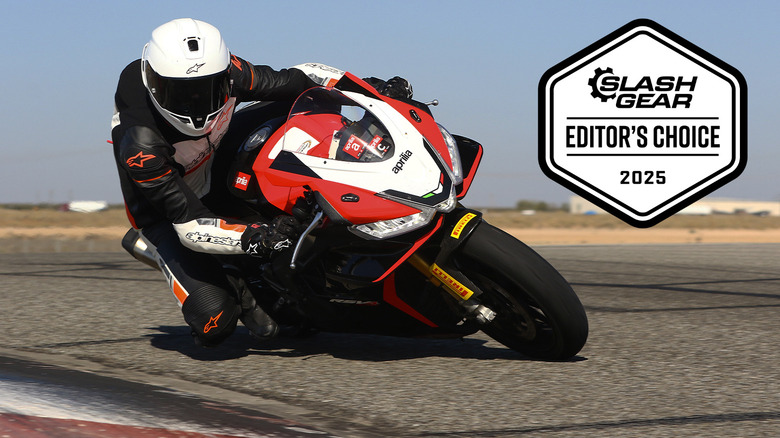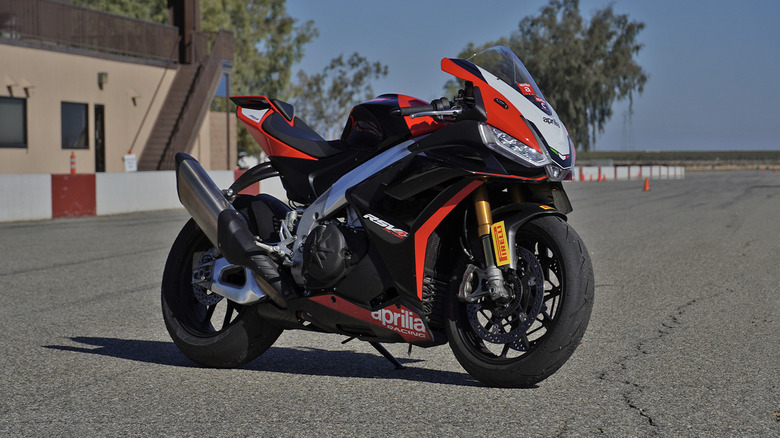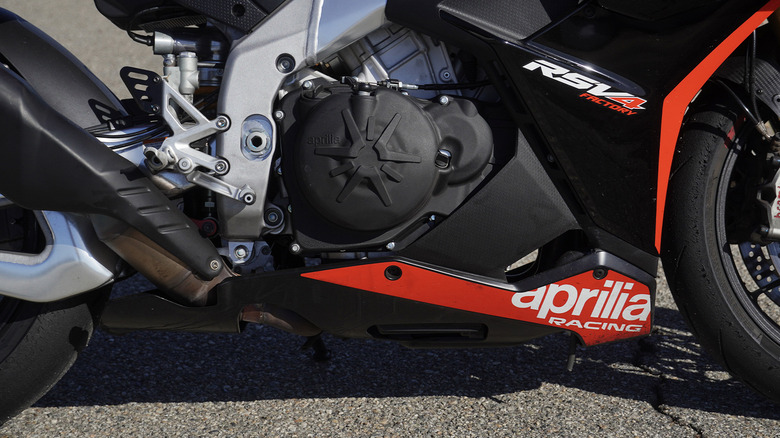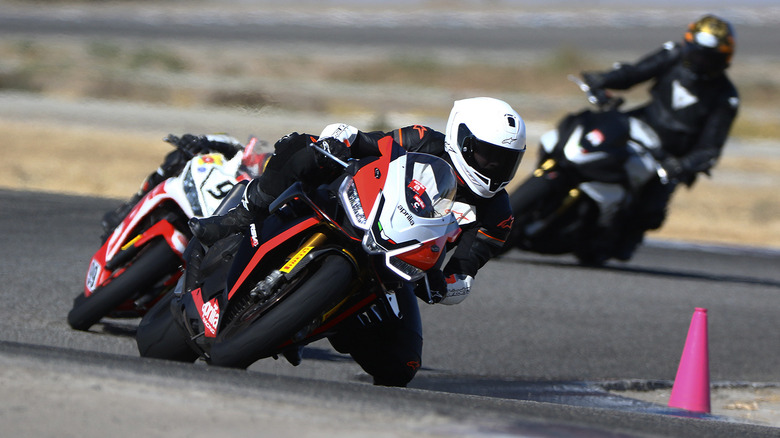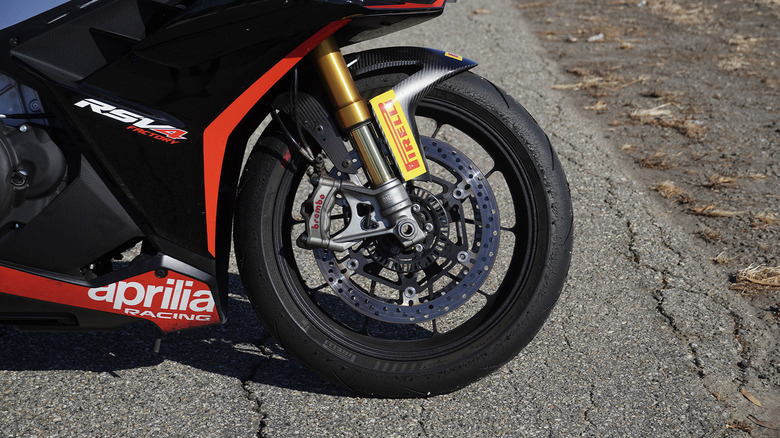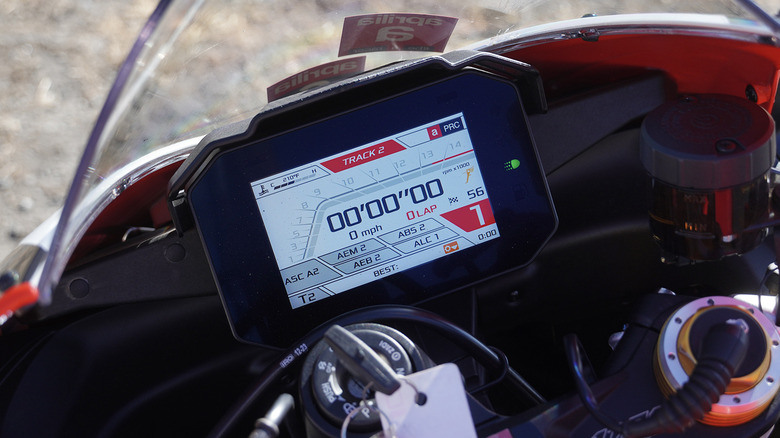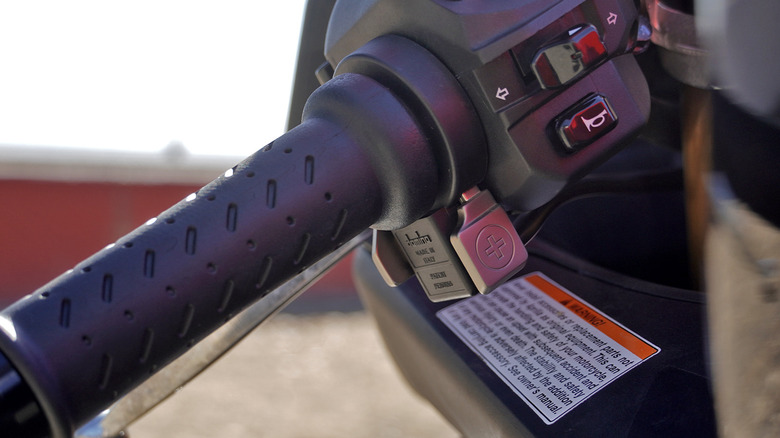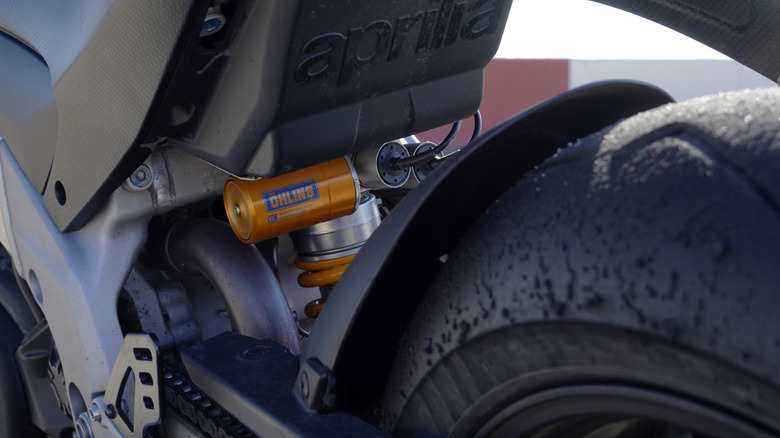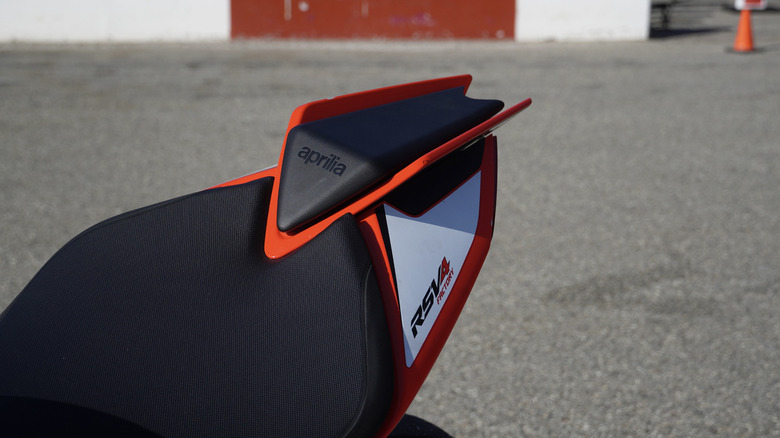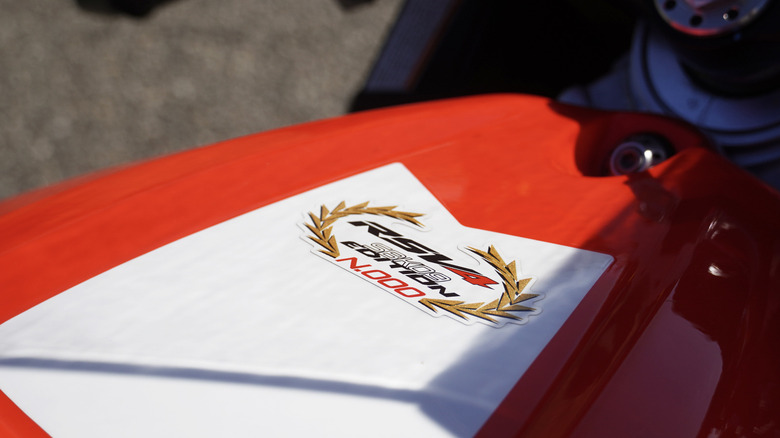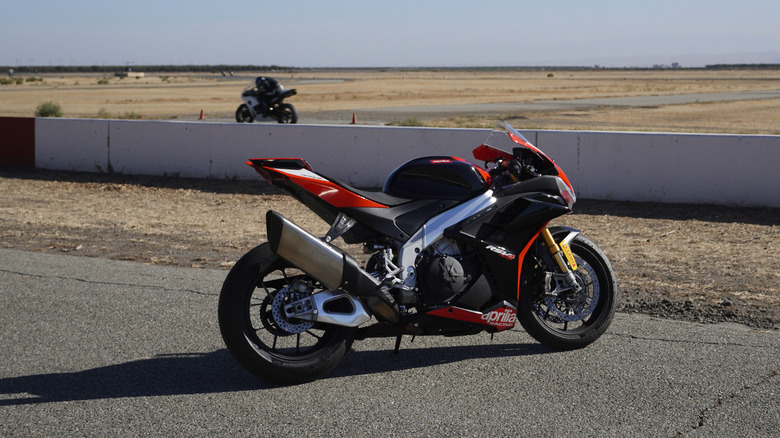Aprilia RSV4 Factory Review: Undoubtedly One Of The Best Bikes Ever
- Seriously spicy power and performance
- Unflappable stability while pushing hard
- Solid electronics suite for every riding condition
- Significantly more affordable than a Ducati Panigale V4 S
- Not quite as refined as the Ducati
- Electronics allow for more shenanigans
- Still very expensive for a track tool
Years ago, early in my motorcycling career, the first bike to truly hit home surprised me. But when I swung a leg over that Aprilia RS 660, such a low, lean, powerful, and nimble motorcycle simply sparked a newfound love for true sport bikes. The experience also prompted some serious curiosity about Aprilia, in general, a brand I knew of previously because my old Volkswagen/Audi mechanic rode Aprilias on the weekend to blow off the steam of working on Volkswagens and Audis all week. So naturally, after the RS 660, I started to wonder about other bikes in the lineup of Italy's "other" sportbike brand.
Sure, Moto Guzzi and MV Agusta fit into the picture, but Aprilia still stands as the only Italian bikemaker to reach anywhere near the towering stature of Ducati. Yet from my mechanic, and a few knowledgeable friends I trust, I also heard that top-spec Aprilias ride with a bit more spice than the best Ducatis. So I wound up quite excited when Aprilia offered me the chance to test the hottest of them all, the RSV4 Factory, on track at California's Buttonwillow Raceway.
Stepping up to the big leagues
I started out at Buttonwillow wanting to warm up to the track, to take a closer look at the famously jumpy and inconsistent surface that I lacked any experience on in either cars or motorcycles. Fittingly, I decided to run a few laps of my first stint on an RS 660, figuring that quite possibly my favorite street bike might serve well for a track intro. But even starting out tentatively, the RS 660 allowed for a bit too much nosedive and felt unhappy with changing levels of traction mid-corner. Power-wise, I managed to get up to a solid pace, though.
At least, so I thought until I swapped onto the RSV4 Factory for the next stint. This specific bike actually wore the limited SE-09 SBK livery, in a tribute to Aprilias racing success, so I pulled out of the pits knowing that I needed to stay sane enough to keep this one-of-2,000 bike riding with the wheels down. Technically, my bike was #000 of that run, as owned by Aprilia, but the RSV4 bones beneath mean ridiculous power, specifically 217 horsepower out of a 1,099-cc engine.
Seriously spicy power
The torque rating matters almost as much, though, at 92 lb-ft by 10,500 RPM on the way to a 13,500-RPM redline. All in a densely packed, lowslung bike that weighs 445 pounds wet. Hence the "spicy" spirit that my friends and mechanic love so dearly. Stepping up from the RS 660, I noticed that 10% increase in weight immediately, and yet the RSV4 also seemed to carry the additional poundage nearer to the ground.
Some of the sensation no doubt stems from the Öhlins forks and rear damper, which allow for electronic adjustment on the fly, but I just set the bike into a mid-level "Track 2" ride mode at first. A nifty button below the left grip controls helps to change traction control modes, but more detailed individual settings via the gauge cluster allow for customization of power output, engine braking, traction control, wheelie control, launch control, ABS intervention, and stability control.
An adjustment period required
Aprilia recommended keeping the power output, which most affects initial throttle response, at a 2 because doing so helps to smooth out on-off modulation while leaned over in corners. That proved wise, as I discovered immediately when I twisted the throttle gently—screwdriver method, of course—out of the first corner and into the racing line. Not ripping at high revs quite yet, even low down in the 3-7,000 RPM range, the RSV4 starts to melt time, bringing up the braking zone in orders of magnitude quicker than the RS 660.
I pulled at the brake lever, again gently at first, but found very little bite. I needed to squeeze surprisingly tight to find any control! Okay, a mental adjustment to the physical response. Through the next few corners I wondered whether the brand-new brake pads needed a few laps to break in. Meanwhile, I started sussing out the RSV4's weight and stability—not so much of the electronic suite yet, but more-so how my own body movements affected the chassis while sliding side to side in my low squat.
Starting to build up pace
Initial impressions revealed the RSV4 Factory's solidly planted footprint, which the lowslung weight probably helps. But the tighter suspension versus the RS 660 also transferred minute shifts in my footpeg positioning and countersteering through to the tires noticeably. I hunkered down, a frog on a cruise missile, noting how quickly the little bumps and sketchy pavement sections that upset the RS 660 seemed to simply disappear on the bigger bike.
In the spirit of full disclosure, I can admit that I never hit full throttle during my first stint out on the RSV4. Yet even at three-quarters and then seven-eighths on Buttonwillow's straightaway, bracing through acceleration and then braking started to tire out my legs, core, and arms. I felt the lactic acid building up, but never noticed my knees starting to tighten or ache as on other compact sport bikes. The body positioning just worked perfectly for me, though admittedly I prefer a high seat and low bars after years of road cycling.
Pondering my commitment to physical fitness
When I took the chequered flag and pulled into the pits after a cooldown lap, the tires needed a few PSI let out. Not bad for a warm-up session, I figured, but vowed to myself to push harder the next session. A few Clif Bloks margarita chews and some chugs from the water bottle later, and my group's turn came once more.
Pulling harder on the throttle to open up that V4 earlier and earlier, all of a sudden my confidence only began to grow. More importantly, the front brakes started to make more sense at higher and higher speeds, since I needed to work physically so much harder under deceleration. Using some coarser muscles actually helped with modulation through the transition from hard straightline braking, as I let the tire contact patch swell while reaching maximum brake pressure, then started to release slowly as I tipped into corners earlier and earlier.
Smooth and speedy, on the straights and through corners
Trail braking on this bike worked gloriously, as I feathered out, the center of mass leaned over with my body even lower, starting to allow further distance in my knees and elbows while easing back into throttle. At 6'1" with hilariously long limbs, I often look cartoonish on a bike—especially in an XXL helmet for my thick skull—but scooting one cheek fully off the saddle still felt natural.
The RSV4, meanwhile, took everything I and Buttonwillow threw at it with aplomb. I started passing other riders now and then, both mid-corner and out on the straights. But building up the confidence to do so and still leave respectful gaps for a fun track day meant that I needed to twist into throttle earlier and earlier. Soon enough, I began to notice some traction control intervention, typically on the first quarter of the main straightaway when the gauges lit up in protest.
Nannies cut in for the win
I say protest because clearly the bike kept trying to save me from my worst inclinations. That engine truly is spicy, ready to rip out so much power from low revs that I risked either upsetting the wheelie control or simply spinning out the rear tire in my urgency. The electronics only weighed in more when I started blipping down an extra gear with the quickshifter to stay at even higher RPMs, engine braking to keep from winging out wide at my lowest lean angles in the hopes of finding the best line to pass slower riders.
Okay, some touchiness, I figured. Or maybe I needed to step up into Track 1 mode. Back in the pits, my Aprilia pro offered to set me up with a lap timer, too, but I declined, preferring to just keep working on pace and focus on experiencing the bike rather than starting to race on the clock and risk damage to this number-zero SE-09 SBK edition. But loosening up the settings to get a teensy tiny bit closer to the edge only revealed more of the RSV4 Factory's capability, and I found more and more speed in every section of Buttonwillow—at least, according to the clock in my head and the seat of my leathers.
Ducati Panigale comparisons are inevitable
To an extent, putting my trust in the machine's brain revealed the biggest difference between this RSV4 Factory and you know who, the Panigale V4 S that absolutely left me head over heels—in love, thankfully, not in an ambulance—while lapping around WeatherTech Raceway Laguna Seca earlier this year. Where Aprilia allowed me to explore just a little past the limit and then dialed me back, Ducati's programming makes the interventions much less noticeable, which only made me feel much better about my own skills as the ones and zeroes worked in the background.
While my ego certainly appreciates the latter, in reality the former may well serve better for honing track skills. On the other hand, Ducati's use of the Öhlins suspension provided a bit more communication of physical traction than the tauter Aprilia. Or, in fairness, maybe I just needed to put some time into dialing in the bike's settings more specifically for my weight and preferences.
A spectacular superbike homage
The Aprilia also looks much more attainable, since even this RSV4 Factory with the SE-09 SBK livery stickers for $26,499 versus a $31,995 ask for the 2024 Ducati Panigale V4 S. Take off $500 for the livery that I don't need, but at this tier I certainly want the Factory upgrades versus a "base" RSV4 at $18,999 without the adjustable track (and road!) goodies.
But of course, Ducati also revealed the 2025 Panigale recently, too, and a friend currently racking up his break-in miles on a brand-new bike already sounds seriously impressed. Without cresting 6,000 RPM, he claims the 2025 V4 S rides with the nimble handling of a middleweight, and that the intuitive software and unflappable stability make an insane liter-plus superbike unbelievably approachable.
Aprilia RSV4 Factory Verdict
More like an RS 660, then? Maybe so, but with the kind of power to scare my pants—or, I should say, leathers—right off. Sign me up, or maybe I should wait to see how Aprilia's inevitable response to the new Panigale turns out in these not-quite-power-wars, given how much EU emissions restrictions cap output to little more than current level. Until some workaround emerges, for now, software development, lightweighting, and aero improvements apparently factor in more for the new frontier of motorcycle manufacturing.
As ever, the question remains whether that software will take some of the ineffable appeal and analog thrill of these current bikes. Yet whenever I revisit in-period reviews of older bikes, the same worries existed back then, too, and I struggle to imagine either Aprilia or Ducati losing that core spirit. Because even if I'm spinning out some stupendously fast, electronically assisted lap times, I'm here more for the fun factor, not to shave tenths. At this top tier of spectacular motorcycles, the fun is worth more than ticks on a clock, dollars and cents, or even brand loyalty. And I can definitely call the RSV4 Factory worth a go, without any doubt or hesitation, for any rider who wants to get out on track and explore the limits of power, grip, sanity, and skill.
